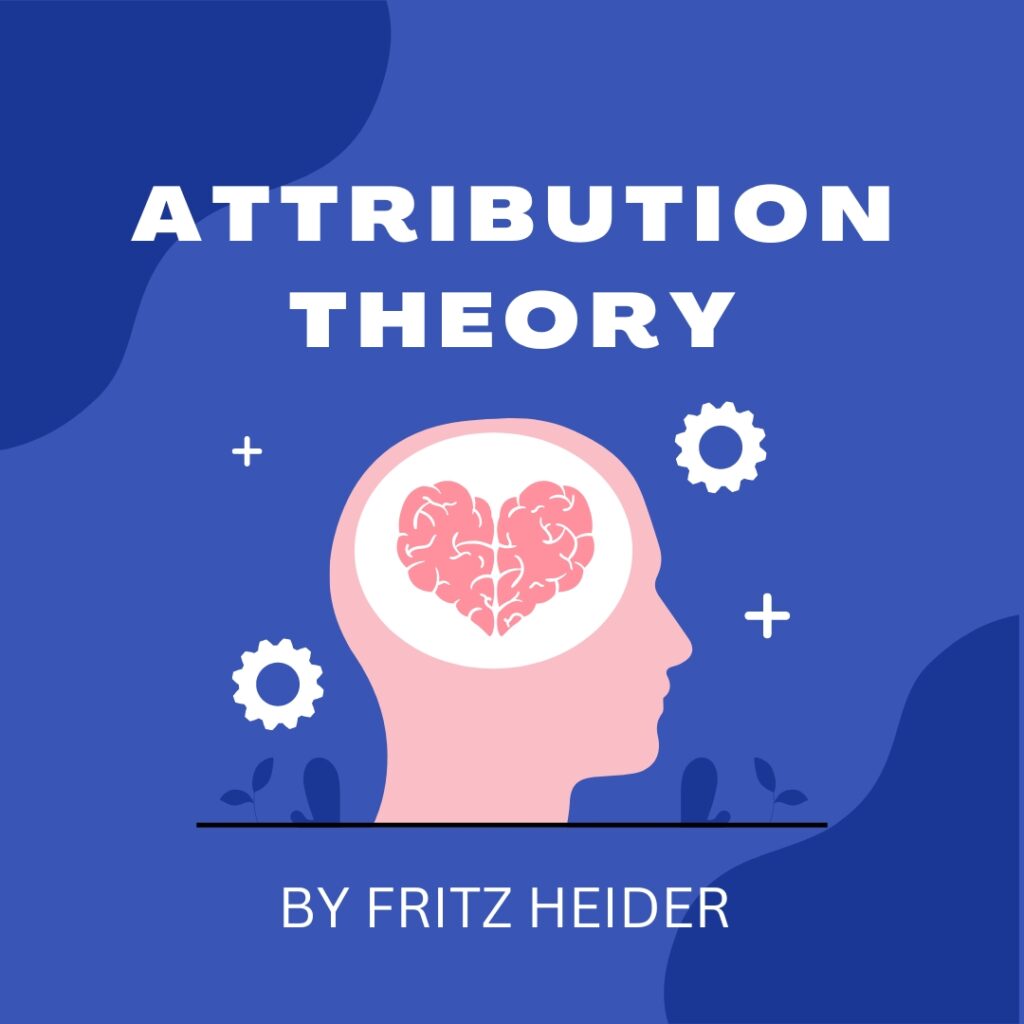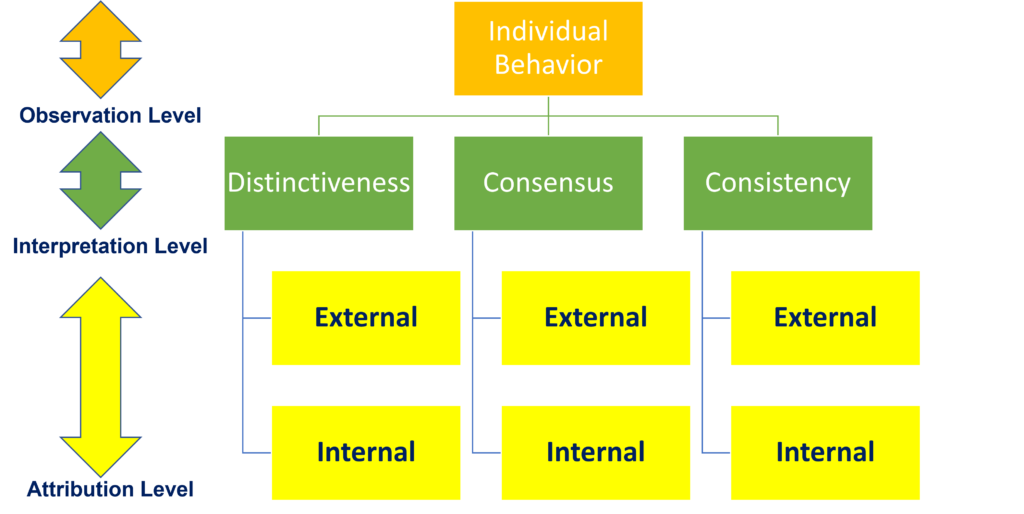
Have you ever wondered what causes people to behave in a certain way and have responses that are uniquely different from others? Attribution theory by Fritz Heider is specifically used to explain this phenomenon. Austrian Psychologist Fritz Heider in his seminal work “The Psychology of Interpersonal Relations” formed the framework for psychological processes that influence human perception. Behavior as Heider believes was an output of disposition (traits, motives, attitudes) or External pressures like social pressure, peer pressure, and acceptance. Heider was among the first to establish that we tend to overvalue dispositional behavior over external behavior which formed the very base for studies of correspondence bias.
Fritz Heider was an Austrian psychologist who is best known for his contributions to the field of attribution theory. Attribution theory by Fritz Heider is concerned with how individuals make sense of the events and situations that they encounter in their lives. It deals with how people explain the causes of their own behavior and the behavior of others, and how these explanations shape their beliefs and attitudes.
Heider’s work on attribution theory began in the 1940s and 1950s, and he is credited with being one of the pioneers of this field. He argued that people have a natural tendency to attribute cause-and-effect relationships to the events and behaviors that they observe. This is known as causal attribution.
Attribution theory by Fritz Heider: Explanation in Layman’s terms
Attribution theory is a way of understanding how people make sense of the events and situations that they encounter in their lives. It deals with how people explain the causes of their own behavior and the behavior of others, and how these explanations shape their beliefs and attitudes.
Fritz Heider was an Austrian psychologist who is credited with being one of the pioneers of this field. According to Heider, people have a natural tendency to attribute cause-and-effect relationships to the events and behaviors that they observe. This is known as causal attribution.
There are two types of causal attribution:
Internal attribution: Internal attribution refers to the idea that a person’s behavior is caused by their own personal characteristics, such as their personality, abilities, or intentions.
External attribution: On the other hand, refers to the idea that a person’s behavior is caused by external factors, such as the situation or the environment.

For example, if someone sees a coworker being rude to a customer, they might attribute the behavior to the coworker’s personality (internal attribution) or to the customer’s behavior (external attribution).
Heider also proposed the concept of correspondent inference theory, which is concerned with how people infer the intentions and dispositions of others based on their behavior. According to this theory, people are more likely to attribute a person’s behavior to their internal characteristics (such as their intentions or personality) when the behavior is voluntary and when there are no external factors that could have caused the behavior.
Heider’s work on attribution theory has had a significant impact on the field of psychology, and his ideas have been widely studied and elaborated upon by other researchers. Attribution theory by Fritz Heider has been used to understand a wide range of phenomena, including how people form impressions of others, how they cope with failure, and how they make decisions. It has also been applied to a variety of fields, including education, marketing, and social psychology.
What are the various elements of Attribution theory by Fritz Heider?
If an observer thinks another person can control their own behavior, they have a high degree of confidence in the assessment that the cause lies internally. As a result, it is generally agreed that an individual has control over their own behaviors, which arise from within.
Behaviors that an observer attributes to external factors are those for which they have a reasonable explanation based on the nature of the situation. Therefore, actions that are triggered by factors external to the actor are not considered to be under the actor’s control.
These observations of human behavior and its attribution to internal and external factors are largely dependent on three factors:
- Distinctiveness or Uniqueness
- Consensus
- Consistency
A person’s uniqueness is measured by how their behavior changes depending on the context. If the same behavior occurs repeatedly, it is likely to have an internal cause; otherwise, it is likely to be the result of environmental influences.
When people reach a consensus, they agree that they would have responded similarly had they been in a similar situation. It is said to be externally driven if everyone responds in the same way; otherwise, it is said to be internally driven.
When something is consistent, it shows a regular pattern of being that way. If consistency is high, internal factors are blamed; otherwise, external ones are blamed.

Explain in detail about internal attribution and external attribution with examples
Internal attribution refers to the idea that a person’s behavior is caused by their own personal characteristics, such as their personality, abilities, or intentions. This type of attribution suggests that the person is responsible for their own actions and that their behavior reflects their inherent qualities or dispositions.
For example, if a student gets a low grade on a test, they might attribute the poor performance to their own lack of effort or ability. In this case, the student is making an internal attribution for the cause of their poor grade.
External attribution, on the other hand, refers to the idea that a person’s behavior is caused by external factors, such as the situation or the environment. This type of attribution suggests that the person is not entirely responsible for their behavior and that other factors, outside of their control, may have contributed to the behavior.
For example, if a student gets a low grade on a test, they might attribute the poor performance to factors such as the difficulty of the test, the lack of time to study, or the distractions in the testing environment. In this case, the student is making an external attribution for the cause of their poor grade.
How is the attribution theory by Fritz Heider used in the understanding of human psychology?
Attribution theory by Fritz Heider is used to understand how people make sense of the events and situations that they encounter in their lives. It helps to explain how people explain the causes of their own behavior and the behavior of others, and how these explanations shape their beliefs and attitudes.
One of the key ways in which attribution theory is used in understanding human psychology is in the study of how people form impressions of others. According to attribution theory, people are constantly trying to make sense of the behavior of others by attributing causes to their actions. For example, if someone sees a coworker being rude to a customer, they might attribute the behavior to the coworker’s personality (internal attribution) or to the customer’s behavior (external attribution).
Attribution theory by Fritz Heider is also used to understand how people cope with failure. When people experience failure, they may attribute the cause of the failure to internal factors, such as their own lack of ability or effort, or to external factors, such as bad luck or the difficulty of the task. Attribution theory can help to explain why some people may be more resilient in the face of failure, while others may be more likely to become discouraged and give up.
In addition, the attribution theory by Fritz Heider is used in the study of decision-making. When people are faced with a choice, they may use attribution theory to help them understand the potential causes and consequences of their options. For example, if someone is trying to decide whether to invest in a particular stock, they might consider the internal factors (such as the company’s financial health) and external factors (such as the state of the economy) that could affect the stock’s performance.
Overall, attribution theory, as proposed by Fritz Heider, is a useful framework for understanding how people make sense of the world around them and how they form beliefs and attitudes about themselves and others. It has been applied to a wide range of fields and has had a significant impact on the study of human psychology.
Use of attribution theory by Fritz Heider used in leadership
Attribution theory by Fritz Heider can be used to understand how leaders make sense of the events and situations that they encounter in their roles. It can help to explain how leaders explain the causes of their own behavior and the behavior of their subordinates, and how these explanations shape their beliefs and attitudes about leadership.
One way in which attribution theory can be used in leadership is in the study of how leaders form impressions of their subordinates. According to attribution theory by Fritz Heider, leaders are constantly trying to make sense of the behavior of their subordinates by attributing causes to their actions. For example, if a leader sees an employee making mistakes, they might attribute the behavior to the employee’s lack of ability or effort (internal attribution) or to external factors, such as a lack of training or support (external attribution).
Attribution theory by Fritz Heider can also be used to understand how leaders cope with failure. When leaders experience failure, they may attribute the cause of the failure to internal factors, such as their own lack of ability or effort, or to external factors, such as bad luck or the difficulty of the task. Attribution theory can help to explain why some leaders may be more resilient in the face of failure, while others may be more likely to become discouraged and give up.
In addition, attribution theory can be used to understand how leaders make decisions. When leaders are faced with a choice, they may use attribution theory to help them understand the potential causes and consequences of their options. For example, if a leader is trying to decide whether to implement a new policy, they might consider the internal factors (such as the support of their team) and external factors (such as the needs of the organization) that could affect the success of the policy.
Overall, attribution theory is a useful framework for understanding how leaders make sense of the world around them and how they form beliefs and attitudes about their own leadership and the leadership of others. It can be applied to a wide range of leadership situations and can provide insight into the decision-making processes of leaders.
Use of attribution theory by Fritz Heider in marketing
Attribution theory by Fritz Heider can be used to understand how consumers make sense of the marketing messages and advertisements that they encounter. It can help to explain how consumers explain the causes of their own behavior and the behavior of others, and how these explanations shape their beliefs and attitudes about a product or brand.
One way in which attribution theory can be used in marketing is in the study of how consumers form impressions of a brand or product. According to attribution theory, consumers are constantly trying to make sense of the marketing messages that they encounter by attributing causes to the information that they receive. For example, if a consumer sees an advertisement for a new car, they might attribute the claims made in the advertisement to the quality of the car (internal attribution) or to the persuasive skills of the advertiser (external attribution).
Attribution theory by Fritz Heider can also be used to understand how consumers cope with negative information about a brand or product. When consumers encounter negative information, they may attribute the cause of the problem to internal factors, such as the quality of the product, or to external factors, such as bad luck or the actions of others. Attribution theory can help to explain why some consumers may be more resilient in the face of negative information, while others may be more likely to avoid the brand or product.
In addition, attribution theory can be used to understand how consumers make decisions about which products or brands to purchase. When consumers are faced with a choice, they may use attribution theory to help them understand the potential causes and consequences of their options. For example, if a consumer is trying to decide whether to purchase a particular brand of car, they might consider the internal factors (such as the reputation of the brand) and external factors (such as the price of the car) that could affect their decision.
Overall, attribution theory is a way of understanding how people make sense of the world around them and how they form beliefs and attitudes about themselves and others. It has been applied to a wide range of fields, including psychology, education, marketing, and social psychology.
What is the attribution theory of distinctiveness?
Attribution theory of distinctiveness is a concept within attribution theory by Fritz Heider that suggests that people are more likely to attribute the behavior of others to their internal characteristics (such as their personality or intentions) when the behavior is unusual or distinct in some way. This theory is based on the idea that people are more likely to notice and remember behaviors that are unusual or stand out in some way, and are therefore more likely to attribute these behaviors to the person’s inherent qualities or dispositions.
For example, if a student consistently gets high grades in all of their classes but suddenly gets a low grade in a particular class, their classmates may be more likely to attribute the low grade to the student’s inherent abilities or effort (internal attribution) rather than to external factors such as the difficulty of the class or the student’s workload. This is because the low grade is unusual or distinct compared to the student’s usual pattern of high grades.
Attribution theory of distinctiveness can be used to understand how people form impressions of others and how they explain the behavior of others. It suggests that people are more likely to attribute unusual or distinct behaviors to the internal characteristics of the person displaying the behavior, while more typical or consistent behaviors may be attributed to external factors. This theory can be applied to a wide range of situations, including social interactions, decision-making, and leadership.
What is the attribution theory of consensus?
Attribution theory of consensus is a concept within attribution theory by Fritz Heider that suggests that people are more likely to attribute the behavior of others to external factors (such as the situation or the environment) when the behavior is similar to the behavior of others. This theory is based on the idea that people are more likely to assume that the behavior of others is influenced by external factors when they see others behaving in a similar way.
For example, if a student consistently gets low grades in a particular class, their classmates may be more likely to attribute the low grades to external factors such as the difficulty of the class or the workload of the students (external attribution) rather than to the internal characteristics of the student, such as their ability or effort. This is because the student’s low grades are similar to the grades of other students in the class.
The attribution theory of consensus can be used to understand how people form impressions of others and how they explain the behavior of others. It suggests that people are more likely to attribute similar behaviors to external factors, while unusual or distinct behaviors may be attributed to the internal characteristics of the person displaying the behavior. This theory can be applied to a wide range of situations, including social interactions, decision-making, and leadership.
Samrat is a Delhi-based MBA from the Indian Institute of Management. He is a Strategy, AI, and Marketing Enthusiast and passionately writes about core and emerging topics in Management studies. Reach out to his LinkedIn for a discussion or follow his Quora Page
